Powered paragliding
Powered paragliding, also known as paramotoring or PPG, is a form of ultralight aviation where the pilot wears a back-mounted motor (a paramotor) which provides enough thrust to take off using a paraglider. It can be launched in still air, and on level ground, by the pilot alone — no assistance is required.
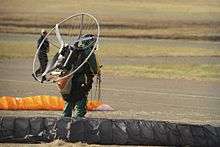 | |
| Highest governing body | Fédération Aéronautique Internationale |
|---|---|
| Characteristics | |
| Contact | No |
| Mixed gender | Yes |
| Type | Air sports |
| Presence | |
| Country or region | Worldwide |
| Olympic | No |
| World Games | 2017 |
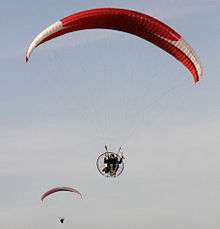
In many countries, including the United States, powered paragliding is minimally regulated and requires no licence. The ability to fly both low and slow safely, the 'open' feel, the minimal equipment and maintenance costs, and the portability are claimed to be this type of flying's greatest merits.[1]
Powered paragliders usually fly between 15 to 50 mph (24 to 80 km/h) at altitudes from 'foot-dragging on the water' up about to 18,000 ft (5,500 m) or more with certain permission although most flying is done under 500 ft (150 m) AGL.[2] Due to the paramotor's slow forward speed and nature of a soft wing, it is not safe in high winds, turbulence, or intense thermal activity.
The paramotor, weighing from 45 to 90 lb (20 to 41 kg) is supported by the pilot during takeoff. After a brief run (typically 10 ft (3.0 m)) the wing lifts the motor and its harnessed pilot off the ground. After takeoff, the pilot gets into the seat and sits suspended beneath the inflated paraglider wing like a pendulum. Control is available using brake toggles for roll and a hand-held throttle for pitch.
Prices for a complete new package (wing, harness, and motor) vary from approximately US$8,000 to $15,000.
Uses
The uses for paragliders may vary, but it is most commonly used for personal and recreational use.
Military
Powered paragliding has seen a large growth in the military including insertion of special forces soldiers and also Border Patrol in many governments. The Lebanese Airborne regiment adopted this technique in 2008. Currently, the US Army, and Egyptian Army have used Paramotor Inc FX Series units for many years, and still under production.
Civilian
Powered paragliders are useful as replacements for terrestrial vehicles in difficult terrain. In some areas during the spring when the sea or lakes are still frozen but the ice has begun melting, the waters cannot be walked, skied, or driven on and cannot be navigated by boat. Hydrocopters, hovercraft, and aircraft are the only ways to travel in such conditions. Furthermore, if the landscape is fractured by small and shallow lakes and bays, as in swamplands, it may be difficult to navigate even in good conditions. Observation and counting of protected species, e.g. Saimaa ringed seal, in such conditions has been conducted using a powered paraglider.
Another use that has been demonstrated is the herding of reindeer. Although the tundra is open terrain, there are no roads and the terrain is still uneven. A powered parachute can be used instead of a snowmobile or a motorcycle.
Safety and regulations
Research estimates that the activity is slightly safer (per event) than riding motorcycles and more dangerous than riding in cars.[3] The most likely cause of serious injury is body contact with a spinning propeller. The next most likely cause of injury is flying into something other than the landing zone.[4] Some countries run detailed statistics on accidents, e.g. in Germany 2018 about 36.000 paragliding pilots registered 232 accidents, where 109 caused serious injury and 9 were fatal [5].
Some pilots carry a reserve parachute designed to open in as little as 50 ft (15 m). While reserve parachutes are designed to open fast, they have a system length between 13.3 ft (4.5 m) and 21.9 ft (7.3 m)[6] and usually need at least 150 ft (46 m) to slow down a pilot to a safe sink rate (certified design speed according to LTF and EN certifications is max 18 ft (5.5 m) per second). With enough height over ground many potential issues with the canopy can be resolved without applying the reserve parachute. The required skills can be acquired in SIV trainings [7], which improve the over all safety of flying by providing a better understand on the system limitations and practical training of extreme situations.
The lack of established design criteria for these aircraft led the British Air Accidents Investigation Branch to conclude in 2007 that "Only when precise reserve factors have been established for individual harness/wing combinations carrying realistic suspended masses, at load factors appropriate to the maneuvers to be carried out, can these aircraft be considered to be structurally safe"[8]
Noise
Paramotor noise relative to an observer depends on distance, loudness, frequency and timbre of the power unit. Most noise comes from the propeller and slow rpm is perceived as the quietest. Pilots mitigate their sound impact by leaving a noise-sensitive area at low power, keeping the farthest practical distance away, and reducing time spent near the area.
License and training
Neither a license nor specific training is required in the U.S., U.K. or many other countries. Where there is no specific regulation (e.g. Mexico), paramotor flying is tolerated provided the pilots cooperate with local officials when appropriate. In countries where specific regulation exists, such as Canada, France, Italy, and South Africa, pilots must be trained, both in flying theory and practice, by licensed instructors. Some countries that require formal certification frequently do so through non-government ultralight aviation organizations.
Regardless of regulations, powered paragliding can be dangerous when practiced without proper training.
For a pilot to get through most organizations' full pilot syllabus requires between 5 and 15 days which, due to weather, may include far more calendar time. A number of techniques are employed for teaching, although most include getting the student familiar with handling the wing either on the ground, via towing, small hills, or on tandem flights.
With special gear it is possible to take a passenger (tandem), but most countries, including the U.S., require some form of certification to do so.
Regulations
In most countries, paramotor pilots operate under simple rules that spare them certification requirements for pilot and gear. Those laws, however, limit where they can fly—specifying that pilots avoid congested areas and larger airports to minimize risk to other people or aircraft. U.S. pilots operate under Federal Aviation Administration regulation Part 103.
Associations
In the U.S., the sport is represented primarily by the US Powered Paragliding Association (USPPA)[note 1] which also holds an exemption allowing two-place training by appropriately certified tandem instructors. The US Ultralight Association (USUA) and Aero Sports Connections (ASC) also offer some support.
Instructors in the U.S. are primarily represented and certified by the United States Powered Paragliding Association(USPPA). Other organizations include the Professional Association of Powered Paragliding Instructors (PAPPI).
In Britain the sport is represented by the British Hang Gliding and Paragliding Association and unofficially by the Paramotor Club.[9]
Trikes and powered parachutes
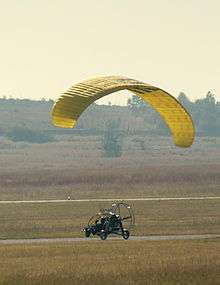
Lightweight carts or "trikes" (called "quads" if they have four wheels) can also be mounted on powered paragliders for those who prefer not to, or are unable to, foot launch. Some are permanent units.
In the United States, if the aircraft meets the ultralight definitions, no license is required. In the UK, trike-mounted paramotors are still classified as 'self-propelled hang-gliders' if the "performance of the aircraft remains equivalent to one that can be foot-launched." [10]. However, even in these countries, if the machine has two seats it is no longer an ultralight. In the US such a craft would be governed under the Sport Pilot rules and regulated as a light sport aircraft powered parachute which requires an aircraft N-number and pilots must be licensed.
A powered paraglider differs from a powered parachute (PPC) primarily in size, power, control method, and number of occupants. Powered paragliders are smaller, use more efficient (but more difficult to manage) paraglider wings, and steer with brake toggles like sport parachutists. Powered parachutes typically use easier-to-manage but less efficient wings, have larger engines, are steered by foot and may be able to take along passengers. There are exceptions; a growing number of powered parachutes use elliptical wings, some use hand controls, and many are light single seat aircraft that meet FAA Part 103 requirements.
World records
Determined by the FAI, RPF1 category.[11]
- The current world altitude record for powered paragliders (RPF1TM) is 7,589m (24 898 ft). It was set by Ramon Morillas Salmeron (Granada, Spain) on 19/09/2009 while flying an Advance Sigma paraglider and a PAP frame powered by a HE R220Duo engine.
- A highly publicized altitude record attempt was made by Bear Grylls on 14 May 2007 at 0933 local time over the Himalayas using a Parajet engine invented by Gilo Cardozo and a specifically designed Reflex paraglider wing invented by Mike Campbell-Jones of Paramania. Cardozo, who also flew in the attempt, had engine problems that ended his climb 300m short of the record. Grylls went on to claim an altitude of 8,990m (29,494 ft), though satisfactory evidence of this claim was not submitted to FAI, and therefore it was not ratified as a world record for this aircraft class.[12]
- Distance in a straight line without landing: 1,105 km (687 mi) set on 23/04/2007 by Ramon Morillas Salmeron flying from Jerez de la Frontera, Cádiz (Spain) to Lanzarote, Canary Islands (Spain) with an Advance Omega 7 paraglider.
Determined by Guinness World Records [13]
- The longest journey by powered paraglider is 9,132 km (5,674.35 mi) and was achieved by Miroslav Oros (Czech Republic), flying throughout the Czech Republic, starting in Sazená and ending in Lipovå-lázn, between 1 April 2011 and 30 June 2011. [14]
- 2nd Longest Journey by Powered Paraglider: 8,008 km (4,976 mi) set on 24 August 2009 [15] by Canadian photographer and documentary filmmaker Benjamin Jordan during his Above + Beyond Canada campaign. In an unprecedented flight between Tofino, BC and Bay Saint Lawrence, NS, the cross-Canada campaign involved 108 flights with landings at schools and youth summer camps along the way. Jordan provided youth with motivational speeches and arranged them in shapes on the ground before launching and continuing on the next leg of his journey. Funds raised over the course of the trip were donated to various charities across Canada to help children from low-income homes attend summer camp.
Images
 Launch of a powered paraglider
Launch of a powered paraglider
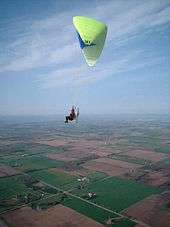 A powered paraglider in flight
A powered paraglider in flight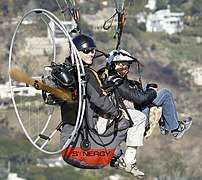 A tandem powered paraglider
A tandem powered paraglider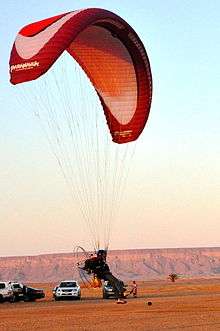 Powered paraglider landing
Powered paraglider landing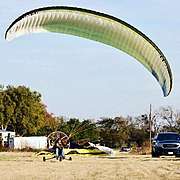 Power paraglider trike launch
Power paraglider trike launch
See also
- Paramotor
- Hang gliding
- Powered hang glider
- Powered parachute
- Powered skydiving, where the participant jumps out of an aircraft
- Kite
- Ultralight trike
- Jet pack: flying with a parafoil and a jetpack
- USPPA
References
- Notes
- Unpowered paragliders are represented by the U.S. Hang Gliding and Paragliding Association (USHPA) which distanced itself from any motorized flying in 2006
- Citations
- Goin, Jeff (2006). Dennis Pagen (ed.). The Powered Paragliding Bible. Airhead Creations. ISBN 978-0-9770966-0-2.
- "Paramotoring Questions Answered". U.S. Powered Paragliding Association. 2006-07-27. Archived from the original on 2007-02-08. Retrieved 2007-01-24.
- Jeff Goin Archived 2019-05-26 at the Wayback Machine, March 2012
- Feletti, F; Goin, J (2014). "Accidents and injuries related to powered paragliding: A cross-sectional study". BMJ Open. 4 (8): e005508. doi:10.1136/bmjopen-2014-005508. PMC 4156803. PMID 25168039.
- "German hang gliding association accident reports".
- Reserve Parachute Manual (contain system lentgh [m]): http://www.x-dreamfly.ch/wp-content/uploads/2019/01/X-TWO_90110130_manual-packing_0119.pdf
- "APPI SIV training".
- UK Air Accidents Investigation Branch "Bulletin S4/2007 Special" Archived 2008-10-22 at the Wayback Machine, August 2007
- "Paramotor Club". paramotorclub.org. Retrieved 2011-10-12.
- https://publicapps.caa.co.uk/docs/33/ORS41253.pdf
- "Microlights World Records". Fédération Aéronautique Internationale, FAI. Archived from the original on 29 May 2012. Retrieved 1 April 2012.
- "Flying over the top of the world". BBC News. 2007-05-17. Retrieved 2010-05-22.
- "Microlights World Records". Guinness World Records. Retrieved 1 January 2013.
- "Guinness Word Records : Longest Journey by Powered Paraglider". Guinness Word Records, UK. Retrieved 30 November 2017.
- "Guinness Word Records : Longest Journey by Powered Paraglider". Guinness Word Records, UK. Retrieved 1 January 2013.
External links
| Wikimedia Commons has media related to Powered paragliding. |
- Paramotor Club - The Paramotor Club
- USPPA - United States Powered Paragliding Association
- ASC - Aero Sports Connection - A web site dedicated to handling operational information, such as forms and requirements for qualifying.
- PPG Videos - Powered Paragliding Videos
- Foot Flyer - Powered Paragliding Information/Reviews
- Parabatix Sky Racers A competition / show based event and generally a great promotion for paramotoring.
- PAPPI - Professional Association of Powered Paragliding Instructors
